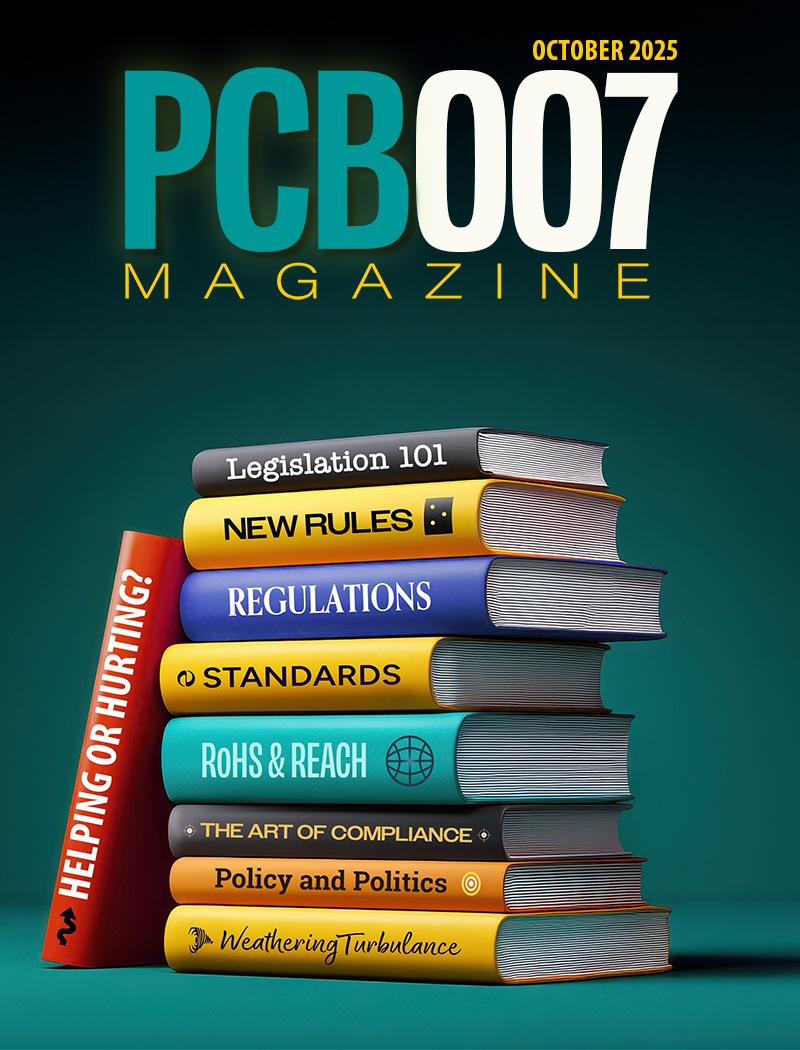-

- News
- Books
Featured Books
- pcb007 Magazine
Latest Issues
Current Issue
The Legislative Outlook: Helping or Hurting?
This month, we examine the rules and laws shaping the current global business landscape and how these factors may open some doors but may also complicate business operations, making profitability more challenging.

Advancing the Advanced Materials Discussion
Moore’s Law is no more, and the advanced material solutions to grapple with this reality are surprising, stunning, and perhaps a bit daunting. Buckle up for a dive into advanced materials and a glimpse into the next chapters of electronics manufacturing.

Inventing the Future With SEL
Two years after launching its state-of-the-art PCB facility, SEL shares lessons in vision, execution, and innovation, plus insights from industry icons and technology leaders shaping the future of PCB fabrication.
- Articles
- Columns
- Links
- Media kit
||| MENU - pcb007 Magazine
Estimated reading time: 3 minutes
Nolan's Notes: Find the Help You Need—Accessing Technical Resources
Some close friends of mine have a card catalog in their family room—with the cards still in it. It’s just a novelty now, but it wasn’t that long ago that the card catalog was the end-all, be-all of research resources. As a college student, I remember something like two dozen or more of the very large card catalog cabinets in the Oregon State University Library. These university libraries had everything from research papers to the rare antiquities housed at the university. The trick was to find what you sought in the catalog and then find it again in one of many diverse library stacks. It’s not lost on me that my friend’s card catalog “liberated” from the university is a snapshot of that particular knowledge base at that particular moment in time. Today’s access to a library’s contents have changed dramatically.
Our knowledge bases in technology, engineering, and manufacturing are constantly changing. Thank goodness we don’t have to refer to card catalogs anymore to manage all the research, standards, and reports we rely on to stay informed.
Among their many virtues, card catalogs told you exactly where to find a particular item. Today’s technical resources, while vast and well-catalogued, might not be as easy to find. We don’t have an industry-wide central location for all our resources. But just like each library was self-contained, so are today’s technical resources. There isn’t one single repository for everything you need to know. You still need to search out individual sources to find individual information. When I was a student, I might first visit my local library, then, if I needed to, I would widen my search. Now, I can still start at the local library, but its connections are much wider and greater. I’m saving myself time and effort and often finding what I need.
Master indexes at each of the various online libraries of industrial technical resources are similarly structured; they contain a complete inventory of what is in that repository. As “students” of our industry, we have an obligation to locate the libraries and then search them for the information we need. To my thinking, there is special commendation for those who, upon finding a hole in the knowledge base, take it upon themselves to do the research and share what they learned.
Now that we’re irretrievably digital, we can search all the card catalogs from the convenience of our desks. Sure, finding and using all the knowledge bases seems a little inconvenient, but at least you don’t have to physically travel around the globe to access the libraries. But where are those libraries, and what is their mission? What information do they intend to archive? How do you use them best?
For this issue of SMT007 Magazine, we contacted several industry organizations and asked them to elaborate on the technical resources they offer.
We kick off the issue with the big three: SMTA, iNEMI, and IPC. Alicia Yao, director of SMTA chapter engagement, walks us through some of the improvements she’s made to the chapter program over the past several months, and the increase to access for SMTA members. Grace O’Malley of iNEMI highlights webinars and the organization’s new user interface. Finally, Sandy Gentry, director of brand management at IPC, provides an overview of resources available for IPC members.
Drilling down throughout the rest of this issue, Chrys Shea and Mike Sivigny introduce us to the new UHDI test vehicle debuted at last fall’s SMTA International. Jordan Labbe of ICAPE Group dives into the European resurgence, and Andreas Salomon introduces us to J.A.M.E.S. and its advocacy work for printed electronics. Teresa Rowe of IPC reminds us that standards committee work can be a valuable—and sometimes overlooked—technical resource in so many ways.
Columnist Mike Konrad addresses the challenges of reliability in harsh environments, while Tom Yang discusses how to overcome cultural nuances when doing business. I also have a follow-up interview with Dennis Reed, who discusses today’s supply chain challenges.
Now that you know where to look for what, I encourage you to dig deeper. Take advantage not only of materials in these libraries, but also the expert knowledge, professional development courses, and other skill-building programs that are available. In this staffing-hungry industry, this kind of effort will make you more valuable than ever.
This column originally appeared in the February 2025 issue of SMT007 Magazine.
More Columns from Nolan's Notes
Nolan’s Notes: Tariffs, Technologies, and OptimizationNolan’s Notes: Everyone Has Their Eye on India
Nolan’s Notes: The Interconnectedness of a Global Supply Chain
Nolan’s Notes: Finding Your Sweet Spot
Nolan’s Notes: Moving Forward With Confidence
Nolan's Notes: The Next Killer App in Component Manufacturing
Nolan’s Notes: Looking Deep Into the Future With X-ray
Nolan’s Notes: Your Golden Ticket


